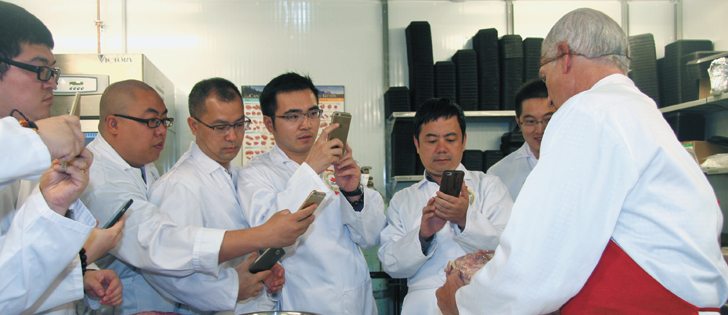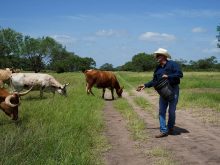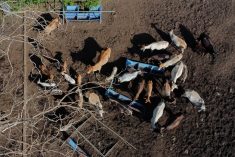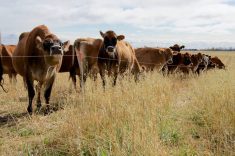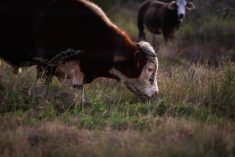Chefs and importers learned about production and the finer points of carving up a carcass, and how to cook different cuts for optimal flavour
The pleasure of good food is the icebreaker when beef experts from east and west meet.
“It is about the food, our cultures and the partnerships,” said Rob Meijer of Canada Beef, which hosts trade missions and education sessions with clients from around the world to build a taste for Canadian beef.
Visitors to the Canada Beef Centre of Excellence in Calgary, which opened in February 2015, are exposed to a one stop showcase about the industry with its system of family owned operations connected to feedlots, meat packers and food distributors.
Read Also

U.S. cattle producers fear return of screwworm
Parasitic screwworm flies are pushing northward from Central America again after being officially eradicated from the United States in 1966, threatening $1.8 billion in damage to Texas’ economy alone.
Chinese chefs and beef buyers representing Michelin star restaurants, high end hotels and meat importers were the most recent visitors, staying in Calgary Aug. 1-6 to learn more about meat cutting and cooking. They also toured a ranch, feedlot, Cargill Meats, grocery stores and restaurants.
The visitors want AAA beef and are eager to learn more about western techniques.
“Western cooking is becoming more popular even in the homes because it is so simple,” said Polly Zhao, who works with the Canada Beef International Institute in Shanghai, guiding trade missions and working on marketing and translations.
As the mother of a preschooler, she knows families are busy and do not have time to prepare a traditional Chinese meal every day.
“We take the best of both worlds,” she said.
Working with chef Marty Carpenter, director of the centre, master butcher Abe Van Melle and sous chef Jonathan Cummings, the delegates received intensive training on cattle anatomy, Canadian style beef cuts and how to cook them.
Demonstrations of this type start in the meat lab, where primal cuts are broken down into a wide variety of cuts. Van Melle also encouraged his students to “tell me how you do things.”
Canada Beef and its predecessor, the Beef Information Centre, pioneered new beef cuts that may be more economical but are tender and tasty. They may come from the shoulder and butt, which are often tougher because the areas are exercised more.
However, within that region are groups of muscles such as the petit tender in the shoulder, which is considered the third most tender cut on a carcass.
Van Melle showed the difference between North American style short ribs and Korean style.
The Korean style is cut into long, thin strips about the same width as bacon, while Canadian ribs are cut between the bones and are square.
Many are familiar with prime rib, but within that same region is rib wedge meat that is good for kabobs.
Rather than producing a big steak, large sirloins can be cut into small beef medallions that are easier to cook and have more eye appeal on a plate.
Canadians could also use more education about these cuts. Carpenter said most buy ground beef, steaks and roasts and do not know about the greater opportunities with smaller muscles that offer more variety.
“Canadian retailers are missing the mark,” he said. “We need to educate them and consumers about new ways with meat.”
Cooking instruction was offered in a convivial atmosphere during the Chinese visit, and everyone was linked by the pleasure of good food. Delegates were also invited to show off their skills.
Recipes and videos of meat cutting and cooking were provided.
The group visited Cargill Meats, where 4,500 head are processed daily in two shifts. Many of the delegates already have done business with the Canadian arm of this international packer. Most of the hides are exported to Chinese tanneries.
The visitors were shown its extensive food safety precautions, grading and how individual animal identity is preserved. Anyone exporting to China must meet these requirements.
Jeff Ball of the family owned Ballco Feeders operation south of Calgary demonstrated individual identification for the company’s 20,000 head and explained the grain-fed program for its traditional cattle and the Wagyu beef program, which exports to Hong Kong, the United States and Japan.
“We were pleased with what we saw,” said Eric Huang of the Xiangyu Group, a state owned company that imports food, agri-products and other bulk commodities. It is China’s largest importer of Canadian beef.
He has witnessed considerable change in China, where people are wealthier and want better quality food, including a higher demand for grain-fed beef. China is importing from Australia and Canada to fit its specifications.
“It is not about the price, it is about the supply,” he said.
The Chinese started to accept western style food in the 1980s and 1990s, and the demand grew.
“Five to 10 years ago you rarely saw Chinese people consume steak,” he said.
Cattle were not commonly slaughtered specifically for the beef market. Most of the beef came from cull animals or old draft animals.
Imported Canadian beef is now frozen and ends up in food service. High end hotels and restaurants can work with it, but the frozen product is not as presentable in the retail market, where everyone prefers fresh.
Part of the problem is logistics. Beef arrives at the main port cities, and getting it inland poses problems.
“Logistically we are not developed enough to distribute fresh, although most people would prefer fresh,” he said. “For people living in the secondary cities, it is hard to get fresh food,” he said.
Food safety is also a growing worry in China, and many prefer imports over domestic products. Substantial amounts of fruit and vegetables come from Taiwan, and more beef and pork are arriving as the Chinese shift their loyalties to food from offshore.
- Canada Beef has helped generate $151 million worth of business from its opening in February 2015 to July 2016. It has hosted 28 international missions with visitors from 19 countries, 141 international companies, 23 domestic missions and 120 domestic companies.
- Canada produces about 1.2 million tonnes of beef a year. It exported 322,343 tonnes last year, representing 36 percent of domestic slaughter.
- Seventy percent of beef exports go to the United States, 10 percent to China, six percent to Mexico, five percent to Japan and three percent to Hong Kong.
- Canada’s beef industry contributes $33 billion worth of sales of goods and services either directly or indirectlyto the economy.


